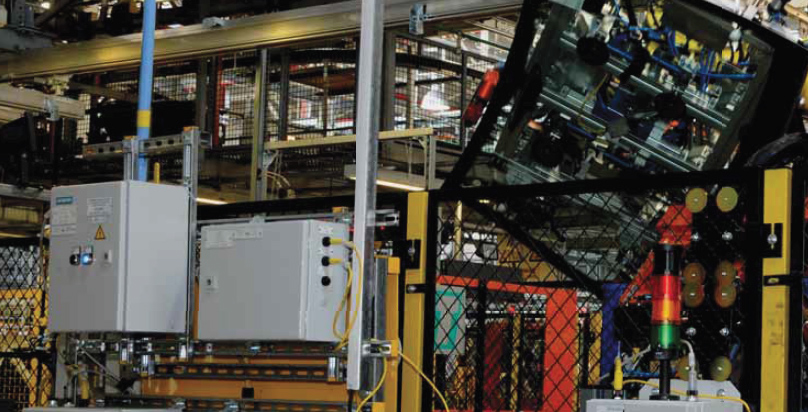
Despite tough economic conditions in Europe, Vauxhall’s Ellesmere Port plant is prepared to face the future head on, as plant director Tom Schmidt, explains
The first car produced by Vauxhall, in 1903, was a 5bhp (4kW) model that featured a tiller steering mechanism. Power was delivered via a two-speed gearbox that had no reverse option. In 1904, the power of the original was tripled and the price was £375.
It’s not stretching the truth to say that Vauxhall has made great progress since those early days. As the UK and Ireland arm of General Motors Europe, the company now offers a full range of cars and vans, including the Astra five-door hatch and Astra Van, both produced at Ellesmere Port, one of the company’s two UK manufacturing facilities (the other being the Vivaro plant in Luton, Bedfordshire). Construction of the Ellesmere Port plant, located approximately 12 miles (19km) south of Liverpool in the north-west of England, began in 1960, with the first production car, a Vauxhall Viva, rolling off the line in 1964. Since then, the plant has weathered a series of downturns, with Schmidt now preparing the plant once again to overcome the latest round of economic challenges, primarily through a programme of built-in flexibility.
Tom Schmidt, Plant Director at Ellesmere Port, has been with GM for 29 years. Originally from Alpine, New Jersey, located directly across the Hudson River from New York City, Schmidt has built up a wealth of manufacturing experience while working in America and around the world. “Most of my career has been spent in North America, although I did spend three years as a plant manager in Egypt. From there I went to Thailand, where I ran the greenfield plant for about three years. Back in the US, my previous job was Director of New Product Launch, North America. “In August 2006 I was given the opportunity to work at Ellesmere Port, and it has been a wonderful experience. Ever since my overseas days, I’ve worked in every one of the four regions (that make up) the corporation, and I’m proud of that. It has been a rewarding career.”
“I’d like to say that the forecast is good, but we all know that’s not true. Our sister plants have implemented some downtime as a result of the economic situation. There is no talk of any line rate reductions here, but we have been allocated a couple of down days as a result of the order intake throughout Europe, keeping in mind that we export about 60 per cent of our products. “When I first got here, I realised we were basically split from Europe. But GM is a global company, so now we’re taking the opportunity to ship to other countries. But not only Vauxhall and Opel. We’ve brought on Holden and Chevrolet to build the business. My attitude was: ‘you tell me what to build and I’ll ship it anywhere’. I did that to ensure that Ellesmere Port had a future, that we had a business plan. We took on a lot of options here. We can build whatever the company wants, whenever it wants.”
Although the Astra Van is produced almost exclusively for the UK market, the five-door hatch is shipped around the world, to countries including (but not limited to) Russia, Australia, South Africa, New Zealand, Belgium, Germany and Ireland. Every brand that offers an Astra model in its range is represented on the production line, with left- and right-hand drive Opel, Chevrolet and Holden models being built together with Vauxhall-badged units. It’s a specific effort to open up multiple outlets for the plant’s output. “RHD, LHD, diesel, petrol – by being flexible, you can quickly meet adjustments in demand. In the past, the request would come in for additional diesel models and that 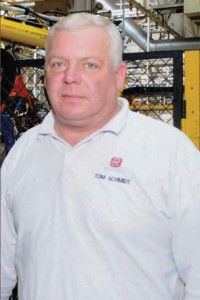 would require a six-month lead time. We don’t have that luxury of time any more, so my issue here is: be as flexible as you can and meet the demand as quickly as you can, with minimal investment.”
would require a six-month lead time. We don’t have that luxury of time any more, so my issue here is: be as flexible as you can and meet the demand as quickly as you can, with minimal investment.”
Putting people first
“Currently, we have about 2,200 employees on two shifts, about 240 of whom are non-production staff,” says Schmidt. “Capacity is rated at about 40 jobs per hour, and through continuous improvement we’re currently at about 42.5. That’s just with ongoing work, with very little investment. “From a quality standpoint, we have a measurement in line with run rate that basically determines the percentage of vehicles that go straight to dealership and what percentage go into another process. About 90.5 per cent come off the line and go straight to dealers. We’ve also made a lot of improvements in our hours-per-vehicle, resulting in a 55 per cent overall improvement. We’re very pleased, from a cost perspective, with our non-scheduled overtime, which we’ve reduced by 75 per cent.”
While Schmidt is clearly keen to produce a quality product, he has placed great emphasis on securing the safety of all staff at Ellesmere Port. “Safety is our overriding priority. We just passed 15 million hours without a lost-workday case. That’s the best record in Europe. We measure ourselves on how many people go to medical, every day of the week. This is reported to me every morning, how many and why, for a headache or a pinched finger, for example. We also calculate what we call ‘near misses’, where you walk around the plant and see a potential safety issue. Maybe nothing’s happened yet, but I want to know how many near misses are reported. That’s not only the managers, that’s down to the team leaders and team members.
“Above and beyond that, we have another level we call ‘recordable’, where somebody might have cut a finger and needed a stitch. If we have a recordable, I personally go out and see the employee to ask what could have been done differently to avoid that injury. The way I look at it, if there has been a recordable, I’ve failed, the organisation has failed, because we did not give the employee the opportunity to come into work and leave in the same condition they arrived.”
The plant is regularly audited for health and safety practices, the last conducted by the GM Auditing Service (GMAS). “I have volunteered to share any of our practices with any other company in the UK. Again, we’re talking about keeping people safe. If we have best practice, the Health and Safety Executive wants to bring our people in. It’s not about competition, we’re talking about people and lives. Safety is not a tool, it is an attitude that everybody needs to have and should be held accountable for when something does not go right.”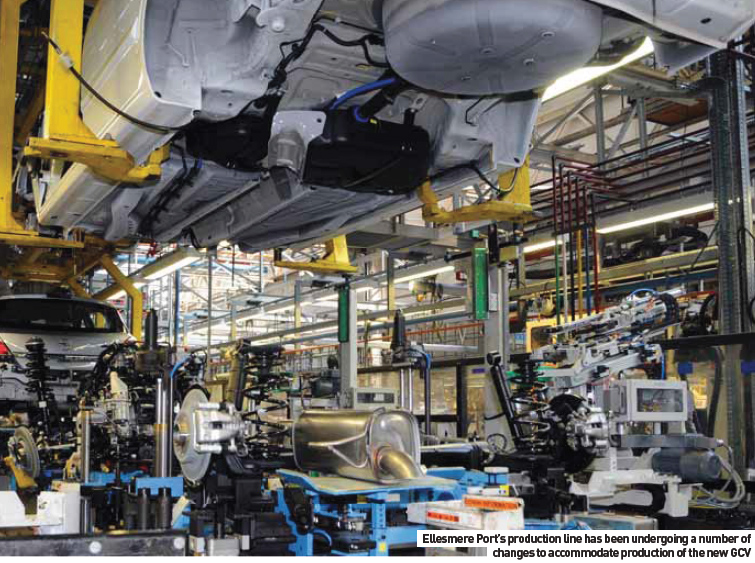
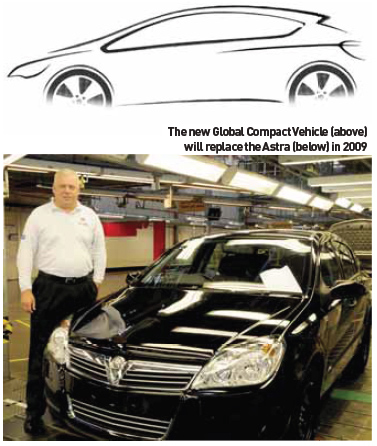 Global Compact Vehicle
Global Compact Vehicle
The replacement for the current Astra, referred to internally as the Global Compact Vehicle (GCV), is due to go into production at Ellesmere Port in the third quarter of 2009. Based on the new Delta platform, this model will carry forward some of the design cues of the recently launched Insignia model, including the wrap-around interior.
“The GCV will start with the five-door hatchback, with the station wagon coming on line in the third quarter of 2010. We don’t have an approved programme as yet for the Astra Van off the new Delta platform, so that will continue to be built on the current platform, on the same line. “Our people have been involved in the build from the start. I sent a team across to Rüsselsheim (Germany) to build the pilots, to ensure we had accountability, the ownership. Now we’ve got some major milestones coming up. We’ll be doing our first strip-and-build vehicle in a few weeks, and in January 2009 we’ll be building our product process validation vehicles, looking at saleable, non-saleable. That should take us through to the Statement of Recommended Accounting Practice.” Manufacturing the GCV will also require some retraining of the workforce. “It’s a new product with less content, so there will be some retraining. Our pilot team has brought back the details they learned while building the vehicles in Germany, and we’re going to start working on the specific job descriptions we’ll need when the GCV starts production.”
Although this is still nearly a year away, the production line at Ellesmere Port is already undergoing the necessary changes to accommodate the new model. “We just took our scheduled three-week summer holiday shutdown. During this period, we did a tremendous amount of work in the bodyshop, installing new robots and new cells for the GCV. I’m very pleased with the results. “In the paintshop, we just redid our topcoat one booth, where we now use water-based paint. This is positive from an environmental and VOCs, product quality and cost perspective. It was a huge project, which I’m happy to say was completed on time. When we started, we were running at about 90 per cent first-time quality in the first week. “We’ve also just installed a global glazing cell, so-called as it is now the global standard for GM. This was also installed during the shutdown and we’re the first plant to use it. Urethane is applied by robot to both the windscreen and rear glass, which are then applied to the vehicle.” Schmidt has a number of reasons for installing the glazing cells in advance of production of the GCV. Further, the efficiency of the new cells is far ahead of what they had in place.
“We had glazing cells before, but these are specifically for the GCV. It’s one of those things where we asked ‘why can’t we do the installation now?’. We wanted to work ahead so that we’d be launching the vehicle and not the process. When the time comes for my non-saleable testing, I’ve already started to validate my manufacturing process, making sure that my takt times are in line, my JES are ready to go, so I can validate how I build the vehicle, not the equipment. “These glazing cells are a lot more efficient. The old technology was a little outdated, there were some issues with aligning the glass in the opening. From a quality perspective, we have only had two instances of water ingress with the new equipment. It’s only been up and running for three weeks, and we’ve had some issues – as you’d expect – but nothing major. We’re looking for consistency and we’ve got that with the new technology.”
Further to the new equipment, Schmidt is also planning on adding a third shift prior to the start of GCV production in the third-quarter, 2009. “Our target is to take the staff we have in the plant today and use that over three shifts, so we’re getting very aggressive in our hours per vehicle. We’ll look to move people into the third shift using the efficiencies gained from outsourcing our module production. It’s a tough target.”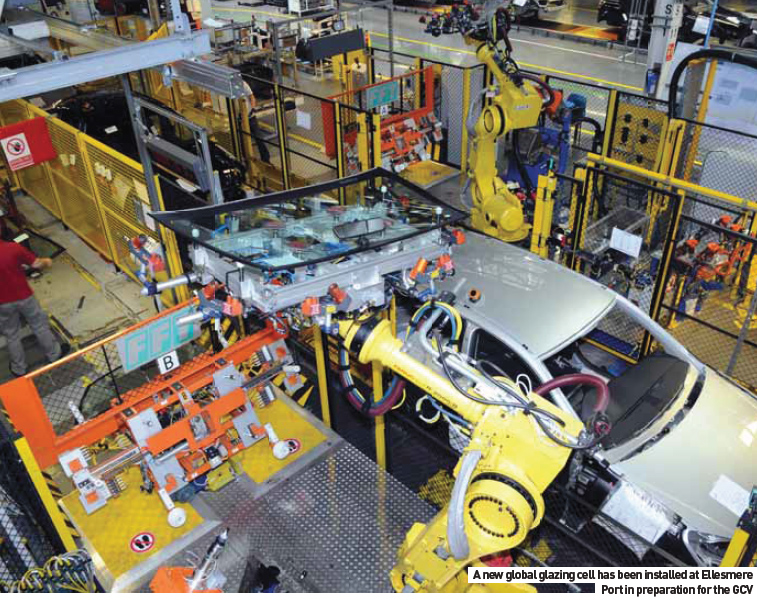
Cutting the fat
Since arriving at Ellesmere Port, Schmidt has been looking at ways of streamlining plant operations. Changes have included bringing suppliers closer to the production line, in every sense of the word. Syncreon, the latest incarnation of what was the formerly GM-owned Delphi, supplies a variety of modules to the plant in addition to SILS. “Prior to my arrival, there were some issues. I can’t say it’s perfect now, but we both understand where we need to get to and we’re getting better at (planning) how we’re going to get there. Since I’ve been here, I think Syncreon has improved, both in meeting our requirements and our expectations. I believe our working relationship has to be a partnership. We’re in business together, and if they’re going to struggle, then I’m going to struggle. Schmidt is clear on where he would like to have his suppliers located.
“I prefer to have my suppliers as close as possible to the line. It all comes down to cost. We’re looking at expanding our outsourcing of module production, but in doing so, we need to make sure that the chosen supplier is in partnership with us. If your supplier is in Europe, it’s very difficult to motivate them from a product quality and cost standpoint. How do you energise them to have continuous (kaizen) improvement when they’re thousands of kilometres away? If they’re on-site, you can have more interaction with them, you can work with them, to make sure they’re meeting your expectations. Not always from a negative standpoint, but to analyse where we’re going, establishing a working relationship.
“Over our summer shutdown, we consolidated Syncreon on-site. We’ve now completed about 85 per cent of the transition, moving the company from supplier park warehousing into our facility, to get them closer to lineside.” The majority of Vauxhall’s suppliers are located in Europe, which, while benefitting other GM operations, can sometimes create problems for the UK-based facility As Schmidt can’t cut costs by physically moving these suppliers closer to Ellesmere Port, he has devised other ways to reduce overheads.
“I am going through a major inventory reduction programme. I’m looking at inventory in the pipeline and process; how many vehicles I have in process and how many I really need, because that’s all money. If I’ve got huge banks of buffers between paintshop and general assembly, say 100 units compared with 42 jobs an hour, that’s two hours worth of inventory, my question is how far can I reduce that? Pushing the process, the organisation, to the edge, that’s OK. That’s where we need to be. “If I have a comfort zone, if I feel good every day of the week because I have a buffer of 100 jobs, there is no sense of urgency. With a robust process, you can create that sense of urgency.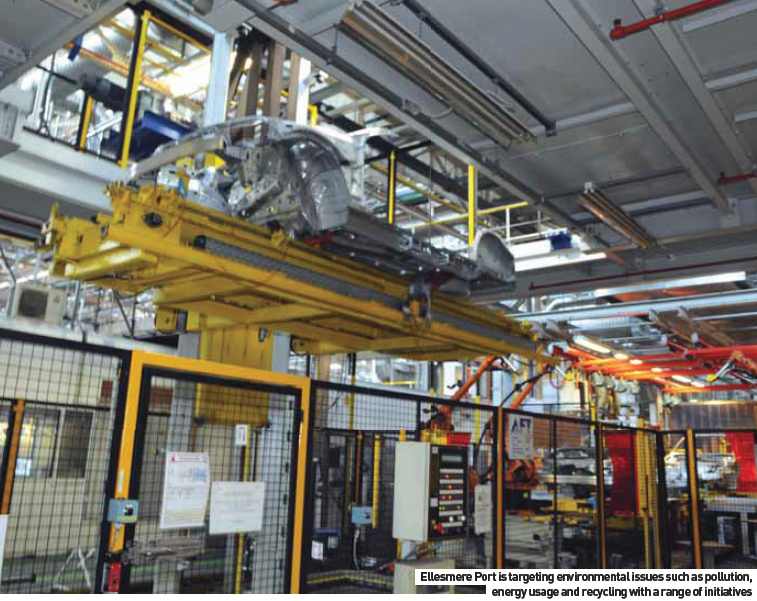
Whatever issue you have, you can react and get the issue resolved quickly. It follows that if you reduce the work in process inventory, you reduce your overall costs. “From pipeline to lineside, in process and what I have out in my peripheral, it’s all low, which is good for the business. I’ve got a compound here on-site with vehicles waiting to be shipped to dealers around the UK. Do we have too many vehicles out there? If we have a batch of 500 units, can we operate successfully with 300? Generally, it comes down to inventory, but look closer and it’s about waste in process.” The press shop at Ellesmere Port supplies both the local bodyshop and other GM facilities with bodysides, doors and underbodies, with 70 per cent of all product used in the manufacture of the Astra Van and five-door hatchback. “In the press shop, I’m investigating how to reduce blank size and line size. I’m challenging the organisation to improve processes, go out there and get aggressive. If you have an issue, or you have a material shortage on line because you reduce material availability too far, I’m going to accept that, because I know that you pushed yourself to the limit.
Green can mean good business
There are a series of environmental initiatives underway at Ellesmere Port, targeting such areas as pollution, energy usage and recycling, most of which are monitored by independent outside agencies.
“The work on our paintshop, while improving efficiency, was also intended to reduce the output of VOCs. To ensure the future of the plant, we had to be careful of exceeding our VOC permit. So we have a test scheduled to measure the difference the work has made. In other words, testing is ongoing.
“We work closely with the government on environmental issues. If there is an issue, we fix it. We’re not in the position where we can hide anything; we are inspected regularly and comply with all governmental recommendations.” Schmidt reviews energy usage across the plant by way of weekly reports, broken down by shop, covering water, gas and electricity consumption.
“There was a case where I kept seeing a spike in water usage on a Saturday, which turned out to be the paintshop flushing outflow. So I challenged that practice, asking if we needed to do this every Saturday, with the resolution of it being done less frequently – resulting in considerable savings.
“We also weld in the dark. Robots don’t need light, they work just as well in the dark, so we turned the lights off. When you open the cell, the lights come on, shut the cell and they go off on a delay switch. “Walking around plants, a lot of the time you can hear air leaks. That’s money down the drain. We’ve worked hard to identify and stop leaks in our system.” According to Schmidt, these and other programmes resulted in a total energy saving of more than 45 per cent. The plant was recognised for its ongoing work in energy conservation with an award from the Energy Efficiency Accreditation Scheme in spring 2007 for maintaining and improving energy usage reductions – the first carmaker in the UK to win the award.
In addition to reducing energy usage, recycling is also an important part of plant operations. Vauxhall recycles all the metal left over from cutting blanks, capturing and bundling the material before it is sold back to supplier Centro. “We do transparent recycling. Over 90 per cent of what we bring into the plant is recycled. That philosophy runs right through the plant. We have a social responsibility, and I’m a firm believer that we need to lead in this area.” Looking ahead, Vauxhall is in the process of arranging a power sharing scheme.
“We’ve a large company close to us with which we’re looking to share energy. If they overproduce, then I will buy their excess. It’s a case of them having too much capacity, so I’ll take some of that excess energy, at a lower cost. That’s the mentality we need to reduce our energy costs. The idea’s not yet finalised, but it’s moving along.”
Something old, something new
Even with production of the GCV starting in 2009, there will be little investment in new line equipment. “I think you need to be careful in manufacturing when considering how much to invest. We need to reuse a lot of what we currently have. As we move towards the GCV, I’m not buying a lot of equipment. Instead, I’m going to see how I can use what I already have. Of course, one of the main factors is cost. What we usually do is say, ‘here’s what you have, make it work’. The global glazing cell was a step up, from a quality standpoint, but there’s a lot of other good technology already on the production line. “I don’t mind updating when the need is there, but I don’t want to update simply for the sake of it. For example, we’re moving over to Rockwell production line software when we start with the GCV. But that aside, you still have to think about what’s in the plant, what can be reused, when you talk about major investments because it’s ‘better technology’. Continue to invest in the latest technology and you put yourself at risk of going out of business.” This was a case in point when it came to winning the GCV contract.
“When we were bidding for the GCV, it wasn’t a case of what do I need? If I was to put a bid in that included the cost of some equipment wish list, they would have laughed at me. So the issue is how to get that product with the equipment and technology you already have.”
“I’m not against investing in technology, but when you continue to invest the money that’s near and dear to everybody’s heart, it goes straight on to the bottom line of how much it costs to produce a vehicle. That goes against my basic objective of building the best quality low-cost vehicle I can.


































